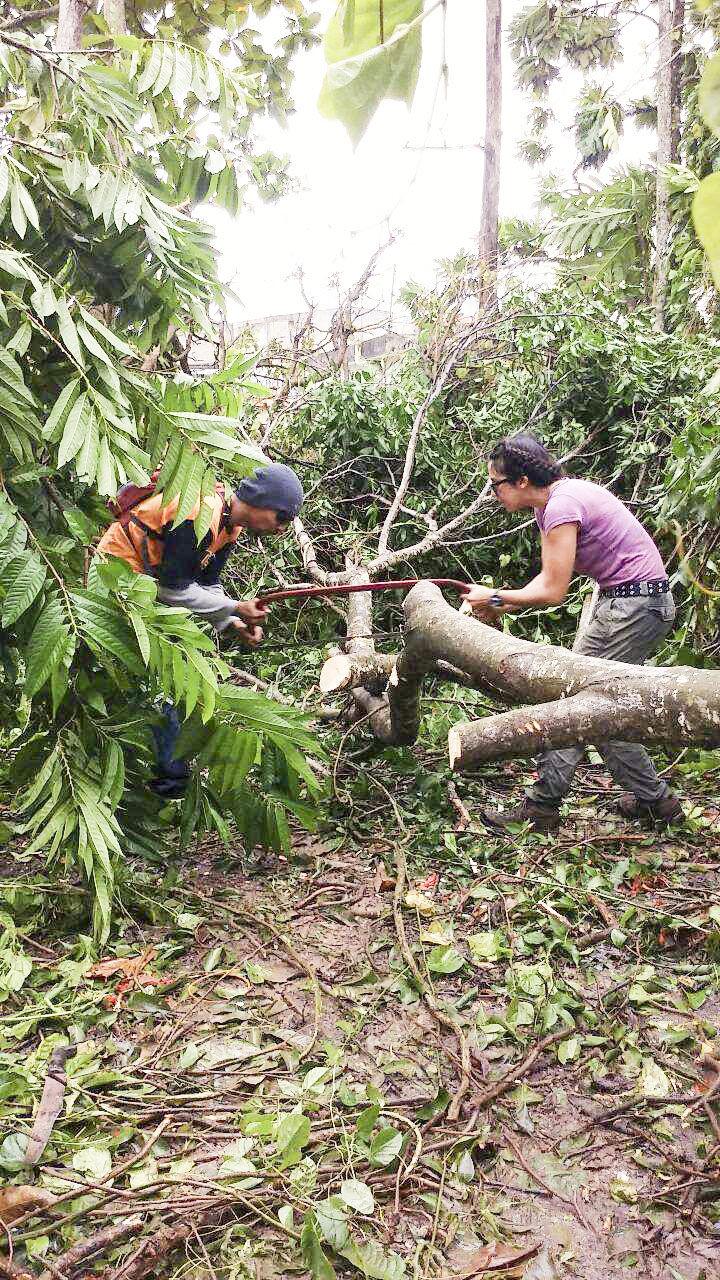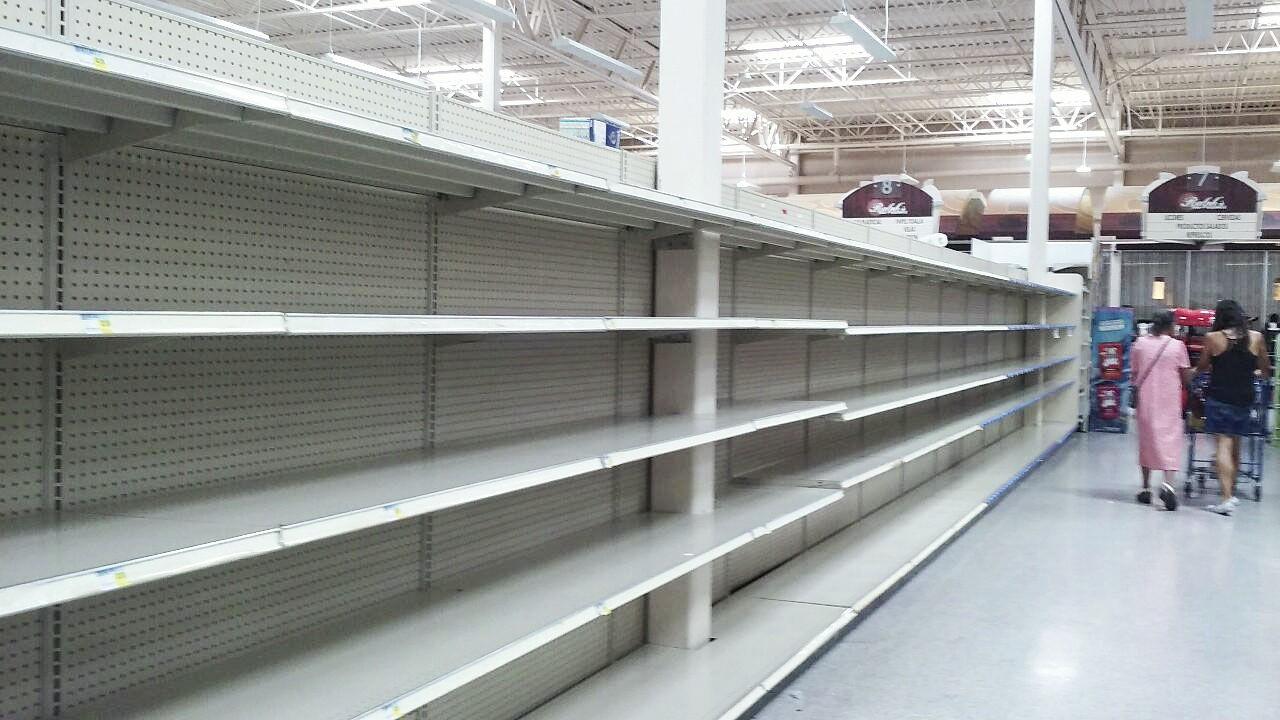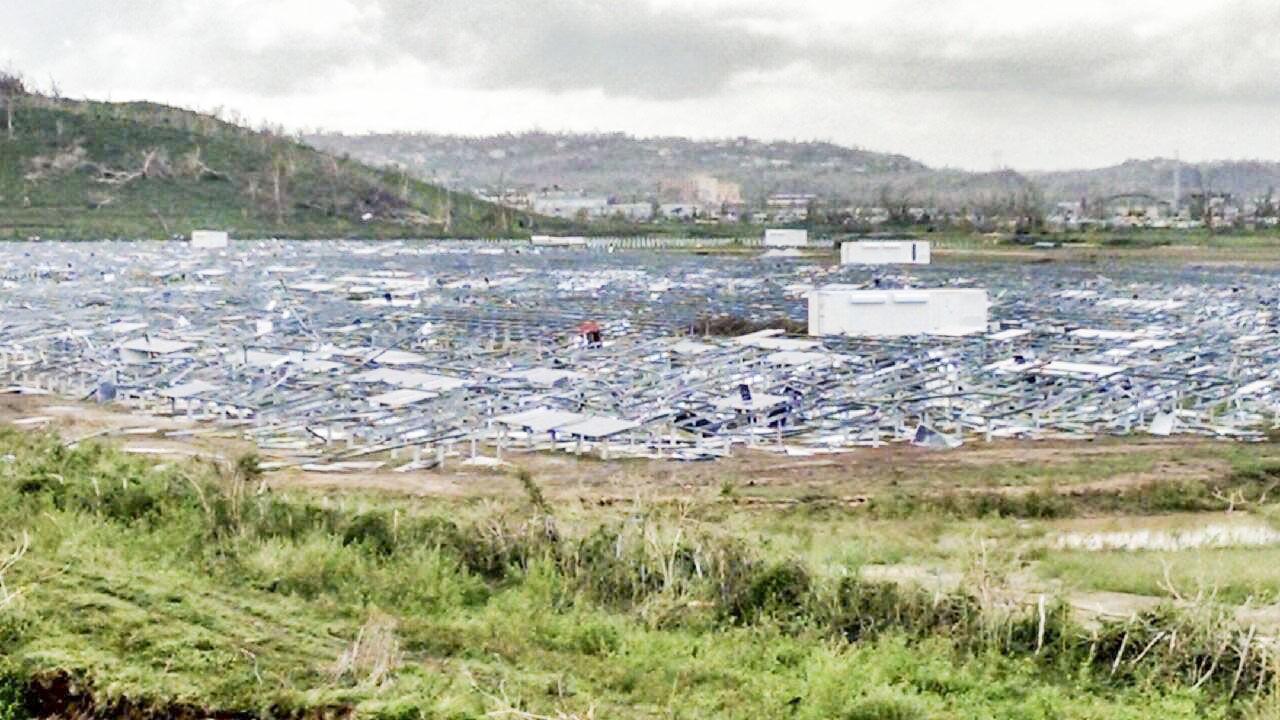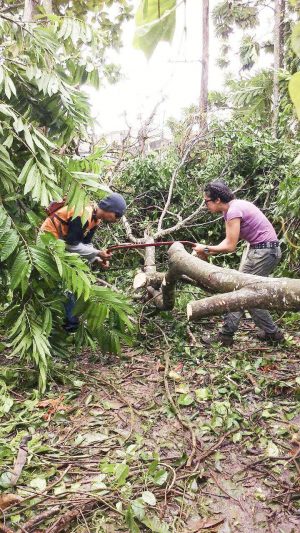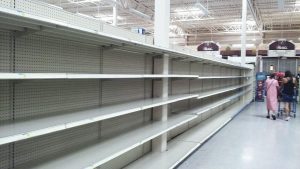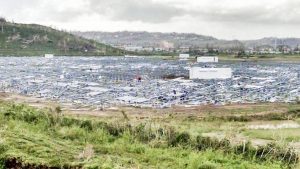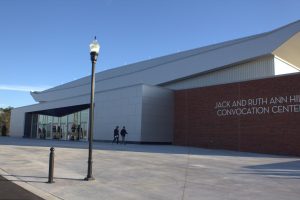Hurricane Maria: How people in Statesboro and Puerto Rico experienced the storm
October 10, 2017
Hurricane Irma had already impacted Puerto Rico two weeks ago. The storm, measured as a Category 5, caused widespread loss of electricity as an indirect hit.
Then, Hurricane Maria arrived. It was a Category 4 storm. This time, it was a direct hit that cut across Puerto Rico from the southeast to the northwest.
Maria further decimated the power grid and cell phone towers, and has made resources such as food, water and gasoline even harder to attain. It has also contributed to 36 official deaths as of Oct. 8, according to CNN and weather.com. Considering communication problems on the island, though, the actual death toll could be much higher.
As well, the storm has impacted relatives of Puerto Ricans. Statesboro relatives of those people all had one thing in common- they seemed anxious to make sure their family was okay.
Making contact
Lizaida Perez-Collazo, senior English major at Georgia Southern University, has family that lives in the southern Puerto Rican town of Ponce.
“There was no way to communicate with them. There’s a pain with not knowing,” Perez-Collazo said.
She especially wanted to talk to family members like her aunts and grandparents who live in Ponce.
“One aunt was able to call from a Chili’s that she works with… I actually missed the call, and I felt so bad, but she got in contact with my uncle [in North Carolina],” Perez-Collazo said. “She wasn’t able to tell us too much, because there were other people in line waiting to talk to their families.”
Her aunt relayed to her uncle that the rest of the family was alright, and that had power. However, they had little water, the aunt said.
Perez-Collazo was also concerned about her other aunt. Fortunately, her maternal grandparents were willing to help with that.
“My grandpa got a ticket for Puerto Rico on Monday [Oct. 2] and he is going to come back on Friday [Oct. 6] with my aunt who has a child and is pregnant, and she’s going to stay with my mom in Griffin,” Perez-Callazo added.
Perez-Callazo elaborated that her grandparents on her father’s side will not come to the U.S. mainland until November. They are trying to address a few concerns like tending to her great-grandparents, who are over 90 years old.
{{tncms-inline content=”<p>&ldquo;Grandpa is in talks with my grandma about permanently moving here, just because they owned a business that was completely destroyed, a restaurant,&rdquo; Perez-Callazo said. &ldquo;It was a boardwalk…they&rsquo;re talking about moving here because the likelihood of that being fixed and moving forward is very low.&rdquo;</p>” id=”4e979112-4fea-43a7-a91d-823ef15ae8aa” style-type=”quote” title=”Pull quote 1″ type=”relcontent”}}
The GS Associate Dean for Student Conduct, Zwisel Gandia Torres, also has family, ranging from parents to grandparents to cousins, in northern and southern Puerto Rico. She heard from her parents the day after the hurricane.
She has learned that her parents’ house partially flooded, and her aunt in southern Puerto Rico, closer to where the hurricane’s eye passed, lost part of her house. However, nobody she knew was injured.
“Let’s be honest, a lot of it [the damage] is material. They’re safe, they’re alive,” Gandia Torres said.
When it’s your child
Other people in the mainland, like GS geology professor Steve Guggino, Ph.D, actually has a daughter, named Ariel, in Puerto Rico.
His ex-wife, Carmen, Ariel’s mother, called the day after the hurricane to tell Guggino that everyone was alright in Fajardo, a town in northeastern Puerto Rico.
“It was such a relief to hear from her, because I was tracking it [the hurricane] all night long, because they [Puerto Rico] got it at night,” Steve Guggino said.
He explained from his observations that Fajardo, being in the east-northeast quadrant of the hurricane’s path, experienced some of the highest winds in the hurricane. The weather had not abated that much when Ariel called him the next day.
“The winds are still 50 miles an hour, tropical storm strength…after that day, I didn’t hear from them for a week,” Steve Guggino said.
Guggino then kept seeing news stories of people dying from mudslides, not having food or water or people being limited from moving supplies because the roads are blocked.
{{tncms-inline content=”<p>&ldquo;[I was] just worried and worried. I keep trying to call and call and can&rsquo;t get through. And then last week, I finally get through,&rdquo; Steve Guggino said. &ldquo;It was such a relief. I was almost in tears.&rdquo;</p>” id=”b4f5cbbd-f5f5-44f7-ac15-cd7a9e5c24be” style-type=”quote” title=”Pull Quote 2″ type=”relcontent”}}
He can now can talk to her once every day or every couple of days. The George-Anne was able to contact Ariel Guggino on Friday, Oct. 6.
What Guggino and her family experienced
Ariel Guggino, 24, is a senior geology major at the University of Puerto Rico in Mayaguez. However, she has been in Fajardo the past couple of weeks.
She originally thought she would stay in Mayaguez, the west coast of Puerto Rico, since the storm was forecast to be Category 1. However, her opinion changed as Hurricane Maria got closer.
“I turn on the news, and they’re like ‘Oh, it’s a category five. And I’m like ‘oh, that’s a different story’,” Ariel Guggino said.
If she had stayed, Guggino would not have been able to communicate with her family in Fajardo. As well, her apartment’s roof is made out of zinc, so she thinks it may not have withstood the storm.
Her mother picked her up on Sept. 18 and they drove back to her mother’s house in Fajardo. The weather worsened and reached its climax in the middle of the night.
“It [the wind] was so loud that to communicate with my mom, we had to shout at each other, literally shout because we couldn’t hear what we were saying,” Ariel Guggino said.
The wind ripped things like the doors to some of Carmen’s storage space, only to throw it back against the windows of the house. Luckily, the windows had protection, Ariel Guggino said.
“Then the winds were so strong, the rain, we could hear coming over… like if somebody was shooting, or like bullets hitting against the windows like that, because it was so hard,” Ariel Guggino said. “Also, the pressure that it made against the house. It was times that we could hear it shake, and the whole house is made of cement.”
They did not open the house’s windows until almost 2 p.m. on Sept. 20 The storm came to a lull for a short time, allowing Ariel Guggino and her mother some time to survey the damage.
“All of the trees were blocking the entrance of my house, so we couldn’t go very far to actually see without a machete, to cut small trails, actually get out and see what was going on in the neighborhood,” Ariel Guggino said.
The wind started to pick up again around 6 p.m., so Guggino and her mother went back inside the house. They went to see her grandparents, whose house is like the family headquarters, the next day, on the 21.
Visiting family
They first had to clear a path for the car, and after doing so, drove until reaching the private road that led to Guggino’s grandparents’ house, which sits on top of a mountain.
“To get to my grandparents’ house, we had to leave the car at the side of the road and get the machete and make a trail… we walked about a mile to get to the house,” Ariel Guggino said.
It took Guggino and her family two days to clear the road to her grandparents’, but they had a little help. While Guggino and her mother were visiting an aunt and uncle, the town had construction equipment out clearing the roads.
“We saw one of them [the machines] clearing up the main road in the county, and we were like ‘hey, could you go up our road?’,” Ariel Guggino said.
While the town workers explained that they put clearing public roads first, Carmen heard one of the workers say that they woke up very early but did not have coffee.
“My mom was like, ‘well, I know where you can get coffee, but if you want to get some, then you’re going to have to clear up our road,” Ariel Guggino said. “They’re like, ‘Damn!’, so all of them came up our road to get the coffee.’ And we were like, ‘we haven’t told you the whole story. You have to go up a hill,’ and they were like, ‘Oh, for coffee, we’ll do anything!’”
The workers then cleared up everything up to the top of hill where Guggino’s grandparents live. They sat and stayed for a while drinking coffee before going back to clearing off public roads.
The struggle for resources
Once they could move around, Guggino and her family noticed that they did not have gasoline for their car or their generator.
{{tncms-inline content=”<p>&ldquo;People like my grandparents, they have a tank full of water, but they can&rsquo;t use if they don&rsquo;t have electricity. That&rsquo;s why they have a generator. That&rsquo;s why they need the gas,&rdquo; Ariel Guggino said.</p>” id=”51e5ef83-0b52-4cdc-b974-12eadd3eab29″ style-type=”quote” title=”Pull Quote 3″ type=”relcontent”}}
Getting gas was challenging, though. Customers in Fajardo would wait in long car lines for a whole day, only to be told not to get full tanks of gas, that a station had sold out or that a station had been confiscated by the government.
Guggino mentioned that her family would bring gasoline back to her grandparents’ house, so that they could share it.
“Same thing with groceries. We bring all of the groceries to my grandma, because she is the only one with a gas stove, so she’s the only one that can cook,” Ariel Guggino said.
The lines for gasoline did not seem as bad as before to Guggino, but transportation opened the door to other needs.
“Now, everyone needs their food. The lines that used to be for the gasoline are now for the supermarkets,” Ariel Guggino said.
She described scenes of supermarkets either being almost empty and letting in a few people at a time or being closed because generators for the stores were not working.
“It worries everyone because we’re consuming, but until now [Oct. 6] I haven’t seen the trucks that bring to the food to the places to be filled up,” Ariel Guggino said.
Even though gasoline for cars is generally more available, Guggino elaborated on a tension between getting power and food.
“The news says we have a lot of food. We’re going to start distributing with the truck drivers,” Ariel Guggino said. “The problem is we’re running low on diesel. Now everyone has generators, and they need diesel to run them. But then if everyone uses the diesel for the generators, there’s not enough for the truck drivers.”
Guggino realizes her situation could be worse. She explained that people in less accessible areas, like the mountains, may not have had any type of help for water or food.
Work and play post-hurricane
With the hurricane knocking out many electrical sources of entertainment, Guggino has found time to chat with her family and neighbors.
“Sometimes my mom and I will sit out on the porch and watch the stars, because finally we can see them,” Ariel Guggino said.
There is also plenty of post-hurricane work to do for Guggino. Her grandparents’ roof is still littered with tree debris. Her grandfather, an electrician, has also needed help providing service to some of his clients.
“His clients can [still] contact him… he gets signals from time to time, or sometimes he can just go to his clients’ house and check in them,” Ariel Guggino said. “So sometimes we get in his truck and help him out, taking gasoline to the generators and helping him out with the work.”
Waiting
Guggino still has not heard any official news from The University of Puerto Rico in Mayaguez, or the west side of the island in general.
“I don’t know anything about my friends, my apartment, my car…anything over there,” Ariel Guggino added, “but once the university says ‘we’re back on schedule’, I’ll go back and study to finish my degree. I’m supposed to graduate in December.”
Though there are many unknowns as Puerto Rico moves forward in the recovery process, Guggino and her family are trying not to focus on the negative.
Ariel Guggino said, “We’re all struggling to find that stuff, but we all have a positive attitude…things happen, but those things, you have no control over them, so you have to look beyond that and do what has to be done.”
{{tncms-inline content=”<p>Here are several of the charities raising funds for Puerto Rico.</p> <p dir="ltr">1.&nbsp;<a href="http://hearttoheart.org">Heart to Heart International</a></p> <p dir="ltr">2.&nbsp;<a href="http://irtleams.org">International Relief Teams</a></p> <p dir="ltr">3.&nbsp;<a href="http://medshare.org">Medshare</a></p> <p dir="ltr">4.&nbsp;<a href="http://projecthope.org">Project Hope</a></p> <p dir="ltr">5.&nbsp;<a href="http://redcross.org">Red Cross / Cruz Roja</a></p> <p dir="ltr">6.&nbsp;<a href="http://unidosporpuertorico.com/en/">Unidos Por Puerto Rico</a></p> <p>If you would like to research these or other charities before donating, you can go to www.charitywatch.org or www.charitynavigator.org.&nbsp;</p> <p><em>Note: This is a suggested, but not exhaustive, list of charities currently raising funds for Puerto Rico.&nbsp;</em></p>” id=”30446dfa-def6-4637-afc0-2cd5a271e35d” style-type=”bio” title=”Fundraising for Puerto Rico” type=”relcontent”}}


